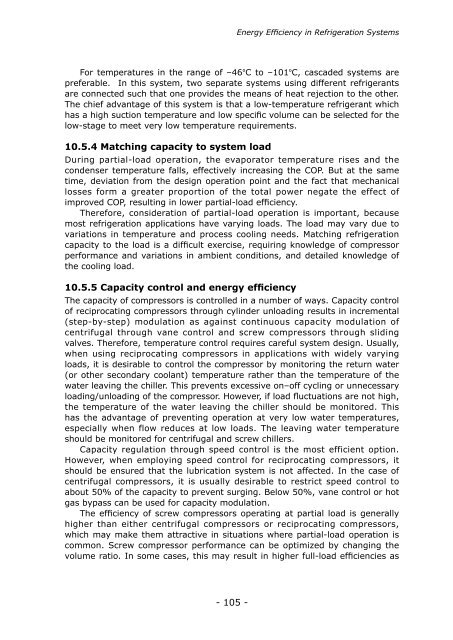Training Manual on Energy Efficiency - APO Asian Productivity ...
Training Manual on Energy Efficiency - APO Asian Productivity ...
Training Manual on Energy Efficiency - APO Asian Productivity ...
You also want an ePaper? Increase the reach of your titles
YUMPU automatically turns print PDFs into web optimized ePapers that Google loves.
For temperatures in the range of –46 º C to –101 º C, cascaded systems are<br />
preferable. In this system, two separate systems using different refrigerants<br />
are c<strong>on</strong>nected such that <strong>on</strong>e provides the means of heat rejecti<strong>on</strong> to the other.<br />
The chief advantage of this system is that a low-temperature refrigerant which<br />
has a high sucti<strong>on</strong> temperature and low specific volume can be selected for the<br />
low-stage to meet very low temperature requirements.<br />
10.5.4 Matching capacity to system load<br />
During partial-load operati<strong>on</strong>, the evaporator temperature rises and the<br />
c<strong>on</strong>denser temperature falls, effectively increasing the COP. But at the same<br />
time, deviati<strong>on</strong> from the design operati<strong>on</strong> point and the fact that mechanical<br />
losses form a greater proporti<strong>on</strong> of the total power negate the effect of<br />
improved COP, resulting in lower partial-load efficiency.<br />
Therefore, c<strong>on</strong>siderati<strong>on</strong> of partial-load operati<strong>on</strong> is important, because<br />
most refrigerati<strong>on</strong> applicati<strong>on</strong>s have varying loads. The load may vary due to<br />
variati<strong>on</strong>s in temperature and process cooling needs. Matching refrigerati<strong>on</strong><br />
capacity to the load is a difficult exercise, requiring knowledge of compressor<br />
performance and variati<strong>on</strong>s in ambient c<strong>on</strong>diti<strong>on</strong>s, and detailed knowledge of<br />
the cooling load.<br />
10.5.5 Capacity c<strong>on</strong>trol and energy efficiency<br />
The capacity of compressors is c<strong>on</strong>trolled in a number of ways. Capacity c<strong>on</strong>trol<br />
of reciprocating compressors through cylinder unloading results in incremental<br />
(step-by-step) modulati<strong>on</strong> as against c<strong>on</strong>tinuous capacity modulati<strong>on</strong> of<br />
centrifugal through vane c<strong>on</strong>trol and screw compressors through sliding<br />
valves. Therefore, temperature c<strong>on</strong>trol requires careful system design. Usually,<br />
when using reciprocating compressors in applicati<strong>on</strong>s with widely varying<br />
loads, it is desirable to c<strong>on</strong>trol the compressor by m<strong>on</strong>itoring the return water<br />
(or other sec<strong>on</strong>dary coolant) temperature rather than the temperature of the<br />
water leaving the chiller. This prevents excessive <strong>on</strong>–off cycling or unnecessary<br />
loading/unloading of the compressor. However, if load fluctuati<strong>on</strong>s are not high,<br />
the temperature of the water leaving the chiller should be m<strong>on</strong>itored. This<br />
has the advantage of preventing operati<strong>on</strong> at very low water temperatures,<br />
especially when flow reduces at low loads. The leaving water temperature<br />
should be m<strong>on</strong>itored for centrifugal and screw chillers.<br />
Capacity regulati<strong>on</strong> through speed c<strong>on</strong>trol is the most efficient opti<strong>on</strong>.<br />
However, when employing speed c<strong>on</strong>trol for reciprocating compressors, it<br />
should be ensured that the lubricati<strong>on</strong> system is not affected. In the case of<br />
centrifugal compressors, it is usually desirable to restrict speed c<strong>on</strong>trol to<br />
about 50% of the capacity to prevent surging. Below 50%, vane c<strong>on</strong>trol or hot<br />
gas bypass can be used for capacity modulati<strong>on</strong>.<br />
The efficiency of screw compressors operating at partial load is generally<br />
higher than either centrifugal compressors or reciprocating compressors,<br />
which may make them attractive in situati<strong>on</strong>s where partial-load operati<strong>on</strong> is<br />
comm<strong>on</strong>. Screw compressor performance can be optimized by changing the<br />
volume ratio. In some cases, this may result in higher full-load efficiencies as<br />
- 105 -<br />
<strong>Energy</strong> <strong>Efficiency</strong> in Refrigerati<strong>on</strong> Systems
















